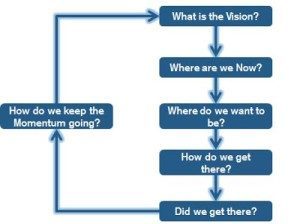The concept of continual improvement is hardly new.
The “small step work improvement approach” was first developed in the US during WWII, and has been a stalwart of business theory ever since.
And let’s be honest, there’s never been a more suitable candidate for continual improvement than the management of IT services.
ITIL Continual Service Improvement
To get us started, this is how CSI is defined on the official ITIL Wiki site.
“ITIL Continual Service Improvement (CSI) process uses methods from Quality Management in order to learn from past successes and failures. The CSI process aims to continually improve the effectiveness and efficiency of IT processes and services, in line with the concept of continual improvement adopted in ISO 20000″.
Seems simple enough, right? In even more basic terms, CSI is nothing more or less than a commitment to providing a higher level of IT service today than you did yesterday.
Many years ago, the ITIL framework used the following diagram to explain the basic process of CSI. Recent versions of ITIL have replaced this diagram with more complex alternatives, but I still think this version is the most helpful way to think about the improvement process.

Let’s take a look at each of these steps in more detail:
1) What is the vision?
Before you can start improving your IT services, you need to know what your ideal future should look like. Typically, this will require you to determine what your customers’ needs are, and how are you intend to meet them.
2) Where are you now?
Next, you’ll need to understand where you currently stand. This could be in relation to your service catalogue as a whole or an individual IT service, but either way it will require an assessment of the people, processes, and technology underpinning your service offering.
3) Where do you want to be?
Once you know your starting point, it’s time to set measurable targets for improvement. The question isn’t simply “where do we want to be?” but “where do we want to be by when?”
The SMART framework is a sensible tool to use here, as it will force you to create targets that can be effectively tracked and ticked off as they are achieved. Ideally, you should aim to set a range of targets to ensure your services are meeting the needs of all stakeholders.
4) How do you get there?
This is the interesting part. Once you know where you are and have determined where you want to be, you must come up with a plan to bridge the gap. As a rule, the more input you have at this stage the better the outcomes you can expect. The basic planning process looks like this:
- Encourage your team to put forward ideas
- Rank ideas according to how well they fit your organization, customers, and vision
- Prioritise ideas that promise the greatest value in the shortest period of time
Remember: CSI is all about small, consistent improvements.
5) Did you get there?
If you did a good job of setting SMART targets, it should be a simple process to determine whether they have been met. Make sure to celebrate and build on successes with your team, and learn from any “failures” that might arise. In reality, the only way to truly fail at CSI is to stop faithfully implementing the process.
6) How do you keep the momentum going?
CSI isn’t something you do once and then forget about. The clue is right there in the name: Continual process improvement.
If you’re taking CSI seriously, keeping the momentum going is the simplest thing in the world: You go right back to the beginning, and start all over again.
…which brings us onto our next point:
CSI Isn’t Actually Process… It’s a Culture
When you look at the ITIL service lifecycle, it’s easy to misunderstand the role CSI plays in IT service management:
- Service strategy — Assess customer needs and determine which services will be offered
- Service design — IT service design or redesign
- Service transition — Build and deploy IT services
- Service operation — Day to day operation of IT services
- Continual service improvement — Continually improve IT services
On the face of things, CSI appears to be quite separate from the other stages of the service lifecycle… but that just isn’t right.
Service improvement isn’t something that can be done in isolation — It can’t be separate from the first four stages. In reality, CSI isn’t a process at all, but a culture that must be embedded in every stage of the ITIL service lifecycle.
This is why securing buy-in from your team is so important to CSI. You can’t expect to see continual improvement unless the people responsible for building and maintaining your IT services are invested in the improvement process.
Which brings us on to our final thought. When IT services aren’t subject to CSI, they don’t simply stay as they are… they stagnate.
Customer and business needs are rarely static, and over time unrefined services gradually become less and less able to meet those needs. CSI isn’t only about service improvement, then, it’s also about ensuring IT services continue to meet the evolving needs of the business.
This is why, in an increasingly competitive world, CSI is so important to the IT function. As businesses are increasingly reliant on IT, they must be able to rely on their IT service to quickly adapt to new requirements.
Ultimately, an IT service that has CSI embedded in its culture will be far more able to adapt to changing business needs than a service that rests on its laurels.
To find out more continual service improvement, and begin your CSI journey, download our free guide:



.png)
